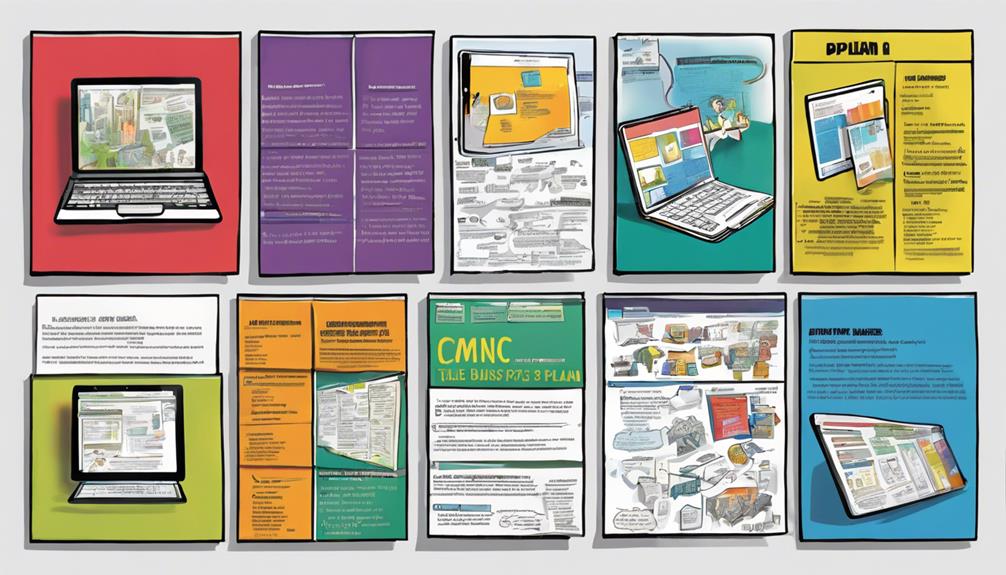Discovering the perfect business plan format begins with understanding your goals and audience. Are you in need of a Miniplan for a quick summary, or a Working Plan for detailed operations? Determine if your target is investors or partners, as each group requires specific elements such as financial projections or operational details. To ensure your message resonates, be clear, concise, and avoid using industry jargon. It is also important to regularly update your plan to reflect market changes and seek feedback to improve your strategy. This mindset will guide you in the right direction, with plenty more to learn about crafting effective plans tailored to your specific needs.
Key Takeaways
- Identify your business goals to determine the appropriate plan type for funding, growth, or risk management needs.
- Consider your audience to tailor the plan format, whether for investors, partners, or internal stakeholders.
- Choose between plan types like Miniplan, Presentation Plan, or Working Plan based on the level of detail required.
- Ensure key elements are included, such as executive summary, market analysis, and financial projections for clarity and effectiveness.
Understanding Business Plan Types

When crafting your business plan, it's crucial to understand the different types available, as each serves a unique purpose and audience.
The Miniplan is perfect for quick overviews, highlighting key elements without overwhelming details.
If you prefer a visual approach, consider the Presentation Plan, which delivers concise information through PowerPoint.
For internal use, the Working Plan offers a detailed, practical guide that focuses on operational aspects.
Finally, the What-If Plan prepares you for unexpected scenarios, helping you strategize for potential challenges.
Identifying Your Business Needs

Understanding the types of business plans lays the groundwork for identifying your specific business needs, which can greatly influence the plan's direction and effectiveness.
Start by evaluating your goals—are you seeking funding, mapping growth, or managing risks? Each need requires a different approach. For instance, if you're focused on securing investors, a detailed working plan or a compelling presentation plan may suit you best.
Consider your audience too; their expectations can shape the information you present.
Key Elements of a Business Plan

A well-crafted business plan includes several key elements that collectively outline your vision, strategy, and operational plan for success.
First, the executive summary gives a snapshot of your business, mission, and vision, capturing attention immediately.
Next, the market analysis dives into your industry, target market, and competition, providing essential insights.
Your marketing strategy outlines how you'll promote your products or services to reach your audience effectively.
Financial projections are vital, as they estimate revenue, expenses, and profitability, showcasing your business's potential.
Finally, the operational plan details production, staffing, and logistics, ensuring you have a roadmap for daily operations.
Together, these components create an extensive guide to navigate your business journey successfully.
Best Practices for Crafting Plans

To craft an effective business plan, it's important to follow best practices that enhance clarity and impact. Start by researching thoroughly; reliable data strengthens your market and financial analysis. Be clear and concise—avoid jargon and make sure your message resonates with all readers. Regularly update your plan to reflect market changes and seek feedback from trusted advisors to refine your approach. Keep your focus on goals, making certain every section aligns with your overall business objectives.
| Best Practice | Description |
|---|---|
| Research Thoroughly | Use reliable data for informed decisions. |
| Be Clear and Concise | Communicate in simple, straightforward language. |
| Update Regularly | Revise the plan to stay current and relevant. |
Tailoring Your Format for Audience

Tailoring your business plan format for your audience guarantees that your message resonates and engages effectively.
Consider who'll read your plan—investors, partners, or internal stakeholders. Each group has different priorities and expectations. For investors, a clear, concise executive summary and financial projections are essential, while partners might need a detailed operational plan that outlines collaboration strategies.
If you're presenting to a non-expert audience, simplify jargon and focus on key points, perhaps using a presentation format. Conversely, if your audience is familiar with your industry, a more detailed working plan might be appropriate.
Understanding your audience's needs helps you choose the right format, ensuring your business plan communicates your vision and objectives successfully.
Common Mistakes to Avoid

Understanding your audience's needs is important, but avoiding common mistakes in your business plan can make the difference between success and failure.
One major pitfall is being too vague; you need to provide specific details about your market analysis and financial projections. Don't overload your plan with jargon—clarity is key.
Also, neglecting to update your plan regularly can render it irrelevant, so keep it fresh and aligned with your current goals.
Another mistake is failing to seek feedback; outside perspectives can highlight weaknesses you might overlook.
Resources for Further Learning

Exploring various resources can greatly enhance your knowledge and skills in creating effective business plans.
You can start by checking out online courses on platforms like Coursera or Udemy, which offer thorough lessons tailored to different business planning formats.
Additionally, consider reading books like 'The Lean Startup' or 'Business Model Generation' for innovative insights.
Websites such as SCORE and the Small Business Administration provide free templates and guides that can streamline your planning process.
Joining local business workshops or networking events can also connect you with experienced entrepreneurs who can share valuable tips.
Frequently Asked Questions
How Long Should a Business Plan Typically Be?
A business plan typically ranges from 15 to 30 pages, depending on complexity. Keep it concise yet thorough, ensuring it covers key components while remaining engaging for your audience. Adjust length based on your needs.
Can I Combine Different Business Plan Formats?
Sure, you can combine different business plan formats! Why stick to one when you can create a masterpiece? Mix a Miniplan with a Working Plan, and voilà—confusion becomes your new best friend. Just keep it clear!
What Is the Best Format for Startups?
For startups, a Miniplan works well, offering essential insights quickly. You might also consider a Working Plan for detailed operations. Tailor your choice based on your specific needs and audience expectations to maximize effectiveness.
How Often Should I Update My Business Plan?
You should update your business plan regularly—ideally every six months or after significant changes occur. This keeps your strategy relevant, allows you to adapt to market shifts, and guarantees alignment with your goals.
Are There Specific Templates for Each Business Plan Type?
Yes, there are specific templates for each business plan type. You can find resources online that offer structured formats tailored to miniplans, presentation plans, working plans, and what-if plans, making your planning process more efficient.
What is the Recommended Business Plan Format for Crafting the Ultimate Guide?
When creating the ultimate business plan crafting the right format is essential. A recommended business plan format includes an executive summary, company description, market analysis, organization & management, product line or services, marketing & sales strategy, funding request and financial projections. Having a clear and concise plan can lead to success.
Conclusion
As you navigate the entrepreneurial seas, choosing your business plan format is like selecting the right sails for your ship. Each type catches the wind differently, guiding you toward your destination.
By understanding your needs and tailoring your approach, you can steer clear of treacherous waters and instead chart a course for success.
Keep your vision clear and your sails adjusted, and you'll find that the journey is as rewarding as the destination.








